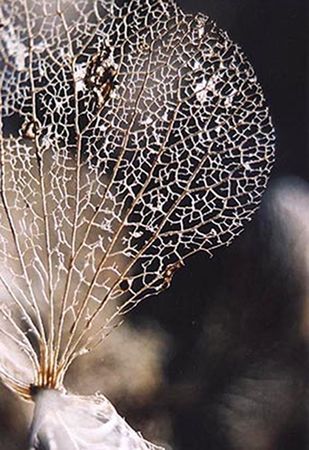
Art collectors on a budget elbow each other out of the way when the Student Art Show and Sale opens at Emily Carr Institute of Art and Design each fall. Now in its 24th year, the exhibition features paintings, sculptures, original prints, and photographs at rock bottom prices. But for the practical-minded connoisseur, there are also functional objects, from handmade ceramic dinnerware to furniture.
Two young artists showing their works in this year’s show demonstrate the impressive range on display: Danielle Hoogenboom and Vendula Ralkova.
‘Illusion and evidence’
Hoogenboom creates photographs packed with mystery. In Miniature Mishap One we glimpse into a young woman’s room: a pink dress hangs on a rack in the corner, while gauzy pastel curtains flutter before a window flooded with sunshine. A sculpture of a dancer sits on the bedside table, picking up the theme of a 50s-style femininity.
But look closer, and the piece takes on sinister overtones. Gloom shrouds the room, despite the brightly lit window. Parts of the image are in focus, others are fuzzy, with a vertigo-inducing inconsistency. The unmade bed, the dresser drawers all-akimbo, and the kicked-off shoes might be signs of mere messiness--but does the dangling telephone receiver suggest some darker reason for the disarray?
Miniature Mishap One is “part of a photographic series that deals with the illusion and evidence of inhabitants and the stories that are left behind,” Hoogenboom told The Tyee. Each photo in the series reveals a different room, but it’s the viewer who “connects the images and thus the narrative,” she said.
The rooms in the photos are obviously staged, but we aren’t looking at a room in someone’s home, but rather at a scale model of the real thing. Hoogenboom builds her photographic “sets” on a one-inch to one-foot scale, creating domestic interiors that recall the homemade dollhouses that were the feature of many girls’ rooms half a century ago.
Hoogenboom’s Classic Girl T-Shirts bear images of retro dolls, and reflect what she describes as her “current obsession with all things girly.” Like her Miniature Mishap One, however, these t-shirt dolls are simultaneously cute and creepy, hinting at the dark side of the gendered culture of the era that gave birth to them.
1919 brings together images rich in narrative, but drenched in mystery. The photographs are made from a book of 100 nitrate negatives she bought at a camera swap meet in Coquitlam last year. “I suspect they are the work of an American Red Cross photographer,” she said. Although she is researching the origins of the negatives, for the time being, it’s the viewer who will have to fill in the narrative blanks of 1919.
‘Smallest thing’
Vendula Ralkova’s work celebrates the beauty of natural and man-made forms. In Pampeliska, the individual spider-like plumes of dandelion seeds are captured with brilliant clarity, while the rest of the tufts hover, cloud-like, in the background. Ralkova delivers intimate views of everyday objects, following the famous dictum of one of her artistic idols, the photographer Henri Cartier-Bresson: "In photography, the smallest thing can be a great subject.”
Praha Socha Atlas offers the viewer a sliver of one of Prague’s 18th century Baroque palaces. Here, we see the Greek mythological figure, Atlas, whose face is etched with effort as he hoists the heavens on his back—his punishment for rebelling against the king of the gods, Zeus. Ralkova, who was grew up in Prague, said Atlas statues are commonly placed on either side of palace entrances, bearing “on their shoulders the weight of the palace structure.”
A streetlamp, with decorative filigree, sharp contours, and precise angles partly obscures the figure of Atlas, and contrasts with the taut curves of his torso. Ralkova evokes the passage of time by juxtaposing the ancient god, the Baroque palace, and a modern version of a 19th century streetlamp--a memento, she said, of “the city’s romantic past.”
From Prague to Vancouver
The changes she sees in her hometown concern Ralkova. “Prague is very fast changing into the world metropolis, and losing its old-time charm. And I’m just trying to still hear the whispering over the roaring of modern fast-paced life,” she said.
Praha pozdniodpoledne fulfills Ralkova’s desire to “evoke feelings and atmosphere.” The last snow of winter slicks the cobbles of an empty street that’s filled with deep quiet and heavy shadows. The gloom, however, is pierced with sun that’s breaking between buildings in the background. For Ralkova, corners of Prague like this one are filled with a sounds of silence. “I can listen there to the whisperings of old buildings, the countless stories of people long gone,” she said.
Before arriving at Emily Carr, Ralkova earned a certificate in professional photography. Her technical strength is apparent in one of the colour photographs in the show, Vejirovitylist, an image of a decaying, fan-shaped leaf, with all the intricate webbing and veins of its skeletal structure intact.
The Student Show and Sale opens Friday, November 26 at noon and continues through the weekend in the Concourse Gallery, Emily Carr Institute of Art and Design, 1399 Johnston Street, Granville Island. Hours: Nov. 26, noon to 5; Nov. 27, 10 am to 6 pm; Nov. 28, noon to 5 pm. For more information, call 604-844-3075.
Judith Ince is a staff writer for The Tyee.
![]()
Read more: Photo Essays















Tyee Commenting Guidelines
Comments that violate guidelines risk being deleted, and violations may result in a temporary or permanent user ban. Maintain the spirit of good conversation to stay in the discussion.
*Please note The Tyee is not a forum for spreading misinformation about COVID-19, denying its existence or minimizing its risk to public health.
Do:
Do not: